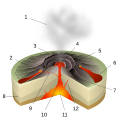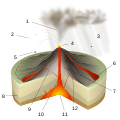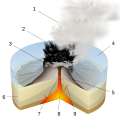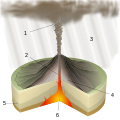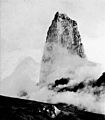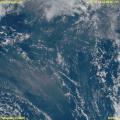Portal:Volcanoes
The Volcanoes portal
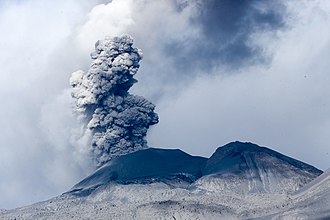
On Earth, volcanoes are most often found where tectonic plates are diverging or converging, and because most of Earth's plate boundaries are underwater, most volcanoes are found underwater. For example, a mid-ocean ridge, such as the Mid-Atlantic Ridge, has volcanoes caused by divergent tectonic plates whereas the Pacific Ring of Fire has volcanoes caused by convergent tectonic plates. Volcanoes can also form where there is stretching and thinning of the crust's plates, such as in the East African Rift and the Wells Gray-Clearwater volcanic field and Rio Grande rift in North America. Volcanism away from plate boundaries has been postulated to arise from upwelling diapirs from the core–mantle boundary, 3,000 kilometers (1,900 mi) deep within Earth. This results in hotspot volcanism, of which the Hawaiian hotspot is an example. Volcanoes are usually not created where two tectonic plates slide past one another.
Large eruptions can affect atmospheric temperature as ash and droplets of sulfuric acid obscure the Sun and cool Earth's troposphere. Historically, large volcanic eruptions have been followed by volcanic winters which have caused catastrophic famines.
Other planets besides Earth have volcanoes. For example, volcanoes are very numerous on Venus. In 2009, a paper was published suggesting a new definition for the word 'volcano' that includes processes such as cryovolcanism. It suggested that a volcano be defined as 'an opening on a planet or moon's surface from which magma, as defined for that body, and/or magmatic gas is erupted.'
This article mainly covers volcanoes on Earth. See § Volcanoes on other celestial bodies and Cryovolcano for more information. (Full article...)
Selected article -
The Mount Cayley volcanic field (MCVF) is a remote volcanic zone on the South Coast of British Columbia, Canada, stretching 31 km (19 mi) from the Pemberton Icefield to the Squamish River. It forms a segment of the Garibaldi Volcanic Belt, the Canadian portion of the Cascade Volcanic Arc, which extends from Northern California to southwestern British Columbia. Most of the MCVF volcanoes were formed during periods of volcanism under sheets of glacial ice throughout the last glacial period. These subglacial eruptions formed steep, flat-topped volcanoes and subglacial lava domes, most of which have been entirely exposed by deglaciation. However, at least two volcanoes predate the last glacial period and both are highly eroded. The field gets its name from Mount Cayley, a volcanic peak located at the southern end of the Powder Mountain Icefield. This icefield covers much of the central portion of the volcanic field and is one of the several glacial fields in the Pacific Ranges of the Coast Mountains.
Eruptions along the length of the MCVF began between 1.6 and 5.3 million years ago. At least 23 eruptions have occurred throughout its eruptive history. This volcanic activity ranged from effusive to explosive, with magma compositions ranging from basaltic to rhyolitic. Because the MCVF has a high elevation and consists of a cluster of mostly high altitude, non-overlapping volcanoes, subglacial activity is likely to have occurred under less than 800 m (2,600 ft) of glacial ice. The style of this glaciation promoted meltwater escape during eruptions. The steep profile of the volcanic field and its subglacial landforms support this hypothesis. As a result, volcanic features in the MCVF that interacted with glacial ice lack rocks that display evidence of abundant water during eruption, such as hyaloclastite and pillow lava. (Full article...)Did you know
- ... that the volcanic chain (pictured) responsible for creating the island of Hawaii extends all the way to the Kuril–Kamchatka Trench, at the border of Russia?
- ... that Nintoku Seamount, an underwater volcano in the Hawaiian–Emperor seamount chain, is over 56.2 million years old?
- ... that volcanoes in the Puyehue Volcano complex may have produced some of the most primitive magmas in the Andes?
- ... that Pilot Rock is one of the oldest volcanic formations in the Cascade Range?
- ... that one of a series of hotels called the Volcano House, built at the edge of Kīlauea volcano since 1846, burned to the ground from a kitchen fire?
- ... that the eruption of Amak Volcano in about 2550 BCE was confirmed by tephrochronology?
- ... that the Bobrof Volcano is an uninhabited island in the Andreanof Islands, part of Alaska's Aleutian archipelago?
- ... that the closest transportation to Davidof Volcano is 199 miles (320 km) away in Adak, Alaska?
General images
Selected biography -

Selected picture
 |
Io moon taken by NASA's Galileo probe. This image shows two volcanic eruptions. The one on the horizon is 140 km (87 mi) high, the other is 75 km (47 mi) high. Io is the innermost of the four Galilean moons of Jupiter. It is named after Io, one of Zeus's many love interests in Greek mythology.
Selected quote
"No one told us we needed a gas mask."
— Tourist visiting the highly active Ambrym volcano, South West Pacific.
Related portals
WikiProjects
Volcanoes topics
Subcategories
Featured work and other approved content

Featured articles: 1980 eruption of Mount St. Helens • 2007–2008 Nazko earthquakes • Amchitka • Armero tragedy • Craters of the Moon National Monument and Preserve • Cerro Azul (Chile volcano) • David A. Johnston • Enceladus (moon) • Geology of the Lassen volcanic area • Io (moon) • Kamaʻehuakanaloa Seamount • Mauna Kea • Mauna Loa • Metacomet Ridge • Mono-Inyo Craters • Mount Cayley volcanic field • Mount St. Helens • Mount Tambora • Nevado del Ruiz • Surtsey • The Volcano (British Columbia) • Triton (moon) • Upper and Lower Table Rock • Volcanism on Io • Volcano (South Park) • Yellowstone National Park
Featured lists: List of volcanoes in Indonesia • List of volcanoes in the Hawaiian – Emperor seamount chain • List of largest volcanic eruptions
Featured pictures: There are currently 43 volcano-related Featured pictures. A full gallery can be seen here.

Good articles: Abyssal plain • Amak Volcano • Anahim hotspot • Axial Seamount • Ben Nevis • Bowie Seamount • Crater Lake • Davidson Seamount • Ferdinandea • Gareloi Volcano • Geyser • Glacier Peak • Hawaii hotspot • Hualālai • Kohala (mountain) • Lake Toba • Minoan eruption • Mount Adams (Washington) • Mount Bailey • Mount Baker • Mount Cleveland (Alaska) • Mount Edziza volcanic complex • Mount Garibaldi • Mount Hood • Mount Kenya • Mount Rainier • Mount Redoubt • Mount Tehama • Mount Thielsen • Mount Vesuvius • Peter I Island • Roxy Ann Peak • Rùm • Sakurajima • Sangay • Silverthrone Caldera • Staffa • Types of volcanic eruptions • Volcanic ash • Weh Island • Wells Gray-Clearwater volcanic field • Yamsay Mountain
Valued pictures: A gallery of volcano-related valued pictures can be seen here.
What you can do

- Add the {{WikiProject Volcanoes}} message box to talk pages of articles within the scope of this project, including appropriate assessments, if needed.
- Add appropriate volcano type categories to articles, and verify the accuracy of any existing categories. See the section "Categorization" below.
- Add {{infobox mountain}} to articles if needed and missing, and add volcano-related fields to existing infoboxes if these are missing.
- Expand volcano articles which are stubs, especially by adding photos and (most importantly) proper references.
- Help improve articles related to Hawaiian and Canadian volcanism by joining the Hawaiian and Canadian workgroups.
- Improve some of the project's most visible articles.
Associated Wikimedia
The following Wikimedia Foundation sister projects provide more on this subject:
-
Commons
Free media repository -
Wikibooks
Free textbooks and manuals -
Wikidata
Free knowledge base -
Wikinews
Free-content news -
Wikiquote
Collection of quotations -
Wikisource
Free-content library -
Wikiversity
Free learning tools -
Wiktionary
Dictionary and thesaurus







